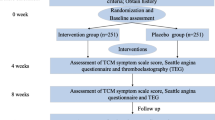Abstract
Objective
To evaluate the effect of anti-platelet regimens and it’s combination with Shuxinyin (SXY,) on in-stent restenosis after stent implantation.
Methods
Forty-four patients with successful stent implantation in a coronary artery were randomly assigned to the treated group (n = 20) and the control group (n = 24). The treated group received SXY and anti-platelet therapy. The control group were treated with anti-platelet regimens only. Platelet activation was assessed before and immediately after the stenting by flow cy-tometry, the expression of P-selectin (CD62P) and glycoprotein(GP) П b/Ш a receptor. It was reassessed on the 30th day after stenting. Plasma fibrinogen (Fg) and C-reaction protein (CRP) were measured by biuret and laser scattering turbidimetry respectively at the same time. Observation was made on the scoring of the symptoms of Qi deficiency syndrome, Qi-Yin deficiency syndrome and blood stasis syndrome in the two groups. Differences between groups were compared.
Results
Compared with the control group, combination with SXY and anti-platelet therapy was remarkable in reducing plasma CRP (P < 0.05), and also with the tendency to decrease plasma Fg, GP П b/Шa and CD62P. It could also evidently decrease the scoring of Qi-Yin deficiency syndrome, Qi deficiency syndrome and blood stasis syndrome after stenting (P <0.05, 0.01, 0.01) respectively. Followup survey found 40 % relapse of angina pectoris with 4 cases of in-stent restenosis proved by angiography in the treated group. But the relapse of angina pectoris in the control group was 67% with 2 cases of mypcardial infarction (MI), 7 cases of in-stent restenosis proved by angiography and one death.
Conclusions
Combination with SXY and anti-platelet regimens can prevent stent thrombosis and in-stent restenosis after stent implantation, and it seems superior to anti-platelet therapy only.
Similar content being viewed by others
References
Neumann FJ, Gawaz M, Ott I, et al. Anti-platelet effect of ticlopidine after coronary stenting. J Am Coll Cardiol 1997; 29:1515–1519.
Rupprecht HJ, Darius H, Borkowski U, et al. Comparison of anti-platelet effects of aspirin, ticlopidine, or their combination after stent implantion. Circulation 1998; 97:1046–1052.
Ma CS, Gai LY, Zhang KJ, et al. Intervention heart disease. 1st edition. Beijing: The People’s Health Publishing House, 1998:335–336.
Gawaz M, Neumann FJ, Ott I, et al. Platelet activation and coronary stent implantation. Circulation 1996; 94 (3): 279–285.
Cardioangiology Committee of Chinese Association of the Integration of Traditional and Western Medicine. Criteria for syndrome differentiation of coronary heart disease. Chin J Integr Med 1991;11(5):257.
The Committee of Study on Deficiency Syndrome and Senile Disease of Chinese Association of the Integration of Traditional and Western Medicine. The reference criteria for differentiation of deficiency syndrome. Chin J Integr Med 1986;6(10):598.
The Committee of Promoting Blood Circulation to Remove Stasis, China Association of the Integration of Traditional and Western Medicine. Criteria for syndrome differentiation of blood stasis syndrome. Chin J Integr Med 1987; 7(3): 129.
Wang J, Chen KJ, Weng WL, et al. Study on the criteria for diagnosis of blood stasis syndrome. Chin J Integr Med 1988;8(10):585–589.
Author information
Authors and Affiliations
Corresponding author
Additional information
Project supported by College Foundation of Shanghai Educational Committee (99C66)
Rights and permissions
About this article
Cite this article
Wang, X., Lin, Zx., Ge, Jb. et al. Effect of shuxinyin on in-stent restenosis after coronary artery stenting. CJIM 8, 167–171 (2002). https://doi.org/10.1007/BF02934300
Received:
Issue Date:
DOI: https://doi.org/10.1007/BF02934300



